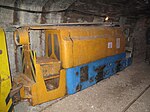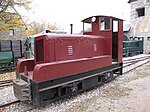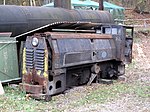Museum train of the Solvay quarries
| Solvay quarries | |
|---|---|
|
Route
| |
| Route length: | 2 km |
| Gauge : | 600 mm ( narrow gauge ) |
The museum railway of the Solvay quarries is a 1.2 km long narrow-gauge railway without the side tracks - museum railway in the open-air museum of Svatý Jan pod Skalou (German St. John under the rock) in the Central Bohemian Region ( Středočeský kraj ) in the Czech Republic .
history
In 1904 the Belgian company Solvay came to Bohemia, specializing in the processing of limestone for chemical purposes. The company set up a factory in Ústí nad Labem-Neštěmice , which produced soda ( sodium carbonate ). Limestone was obtained from various suppliers throughout the Czech Republic for the production. This turned out to be unprofitable and therefore in 1916 it was decided to open its own limestone quarry.
The area of Svatý Jan pod Skalou was selected as a deposit of high quality limestone. In 1917 a geological survey was carried out which confirmed the required material quality. The property was purchased for 50,000 crowns from the then owner of the Johannisgut, Václav Komenda. Then the preparatory work including the construction of the funicular began.
Commercial mining began on June 27, 1918. Shortly afterwards, the first train loaded with limestone from the Solvayovy quarries arrived in Neštěmice.
Quarry expansion
The original quarry was on the northern slope above the village of Loděnice . The growing demand for limestone led to the opening of the south quarry, which in 1930 was connected to the north quarry of Brausewetter & Pittel by a 217 m long tunnel . The southern quarry had three stories and the stories were connected by a funicular that was powered by a winch powered by compressed air.
Material handling
Funicular
The construction of the over 1500 m long funicular began with the construction of the quarry by J. Pohlig. It has been in operation since mining began in 1918. It connected the quarry with the railway in Loděnice. The conversion took place in 1932, and in 1959 the valley station was converted for loading into trucks. It was demolished in 1965, only the upper cable car station, which is waiting to be renewed, has been preserved.
The museum has the only cable car exhibition in the Czech Republic. In 2003 it was possible to acquire the remains of the cable car from Wienerberger from Lišov in the České Budějovice district . In summer and autumn 2003 part of the station technology (drive without motor, rail) was dismantled and transported to the open-air museum. Unfortunately, the original couplings could no longer be obtained, so another transport system (Bleichert) will be used until further notice.
Narrow gauge railway
A track with a gauge of 600 mm was laid in the quarry . Until 1929 the carts were moved manually. In 1930 the first T 290 petrol locomotive was bought and after the Second World War , Stavoloko BNE 25 locomotives were used here. The vehicle fleet consisted of dump trucks and wagons with wooden frames.
Today, several diesel locomotives are used on the railway for museum railroad traffic and occasionally steam locomotives from other railways, e.g. B. A replica of an O&K Cn2t steam locomotive of the 1st Kolínská Lokomotivní from 2014 was a guest there.
Mining shutdown
The Solvay company stopped mining in 1956 and handed the quarry over to the Prague Road Administration, Beroun branch. This company mined material there for the construction of the surrounding roads. The railroad tracks were destroyed as the material was transported with Tatra 111 trucks. Mining ceased in 1964 and the quarry was orphaned temporarily but not forever.
Barbora Society
In 1993, the Společnost Barbora os, the later Společnost Barbora zs, was founded, a society for the preservation of mining and industrial monuments. This company renovated the narrow-gauge railway tracks, looked for old locomotives and wagons and put them back into operation and repaired other machines and systems.
Today there is a museum for limestone mining and transport, about two kilometers of track, 139 meter old tunnels, about 150 wagons of various types and 26 locomotives (MD 2, BN 30, BN 30 R, KLM 5, MŠ 2, AK 2, BN 60 H, DH 120, etc.) A track for the third level of the quarry is under construction and the project includes a track to the village of Bubovice (a total of approx. 5 km). It is also planned to renew the mountain station of the funicular.
Climb
The rock massif in the Paraple quarry with two walls up to 30 m high has been one of the mountaineering areas in the Czech Republic since 2014. The left part, however, was so affected by blasting during mining that the rock is brittle.
Locomotives
| Type | image | Remarks |
|---|---|---|
| BN 15R |

|
|
| BN 30 |  |
|
| BN 30R |  |
Seven locomotives: |
| BN 60H |  |
Three locomotives: |
| BND 15 |  |
|
| BND 30 |  |
|
| ESD 50 |  |
Two locomotives:
|
| Deutz |  |
|
| DH 30 |  |
|
| DH 120 |  |
|
| MD 2 |  |
Web links
Individual evidence
- ↑ Lanove-drahy.cz: Solvayovy lomy - Loděnice (zrušena).
- ↑ Kudyznudy.cz: Říjnové víkendové parní jízdy ve skanzenu Solvayovy lomy.
- ↑ Lezec.cz: Průvodce Solvayovy lomy.
Coordinates: 49 ° 58 '35.2 " N , 14 ° 8' 55.4" E


